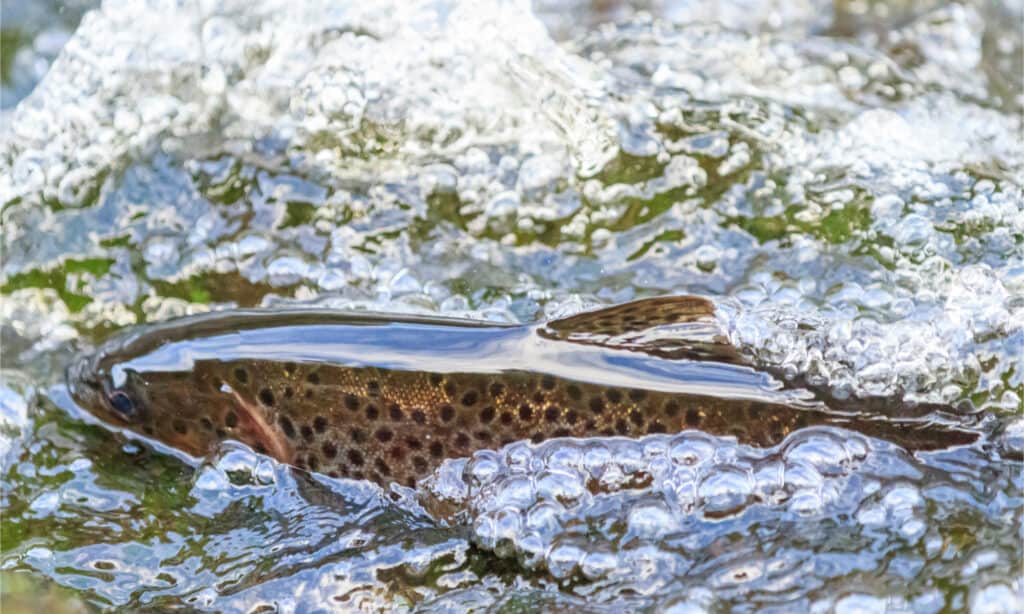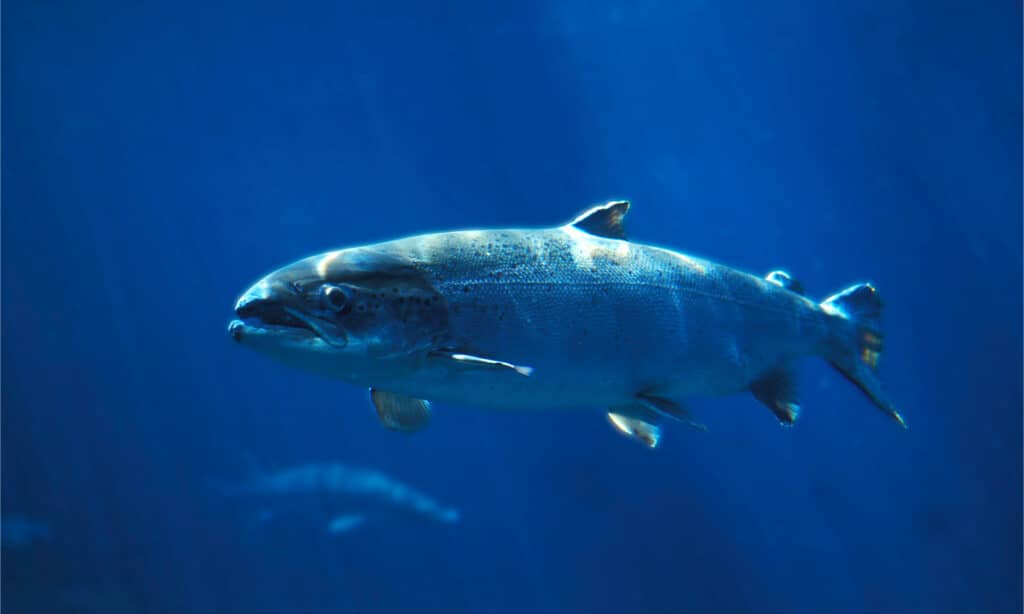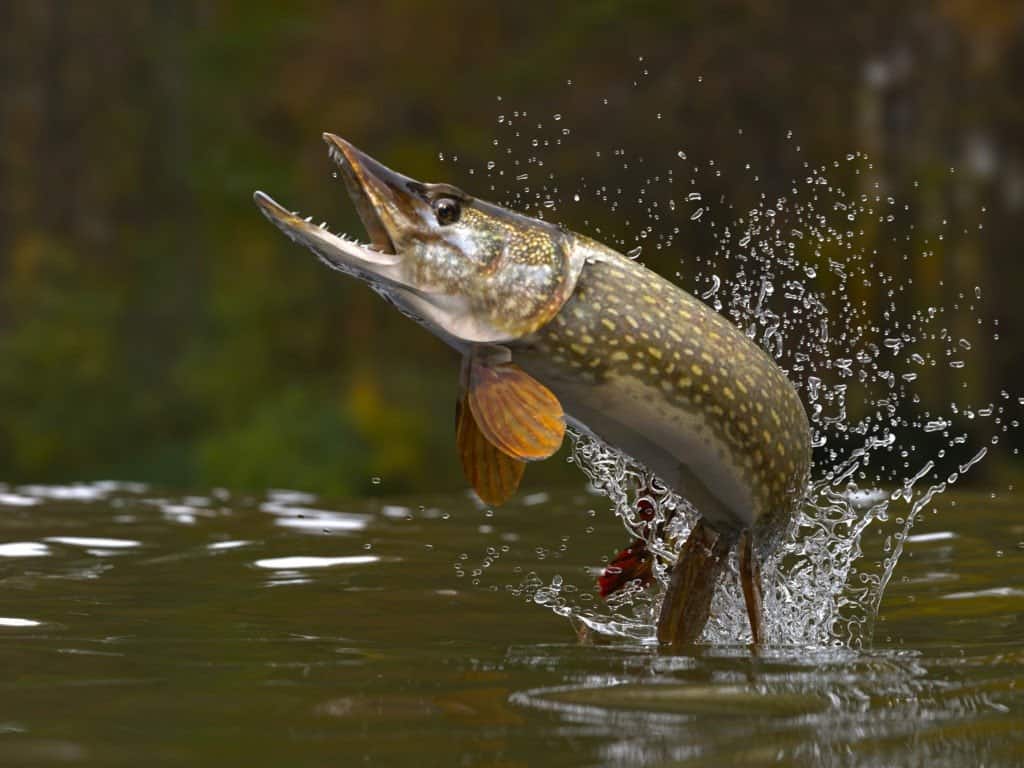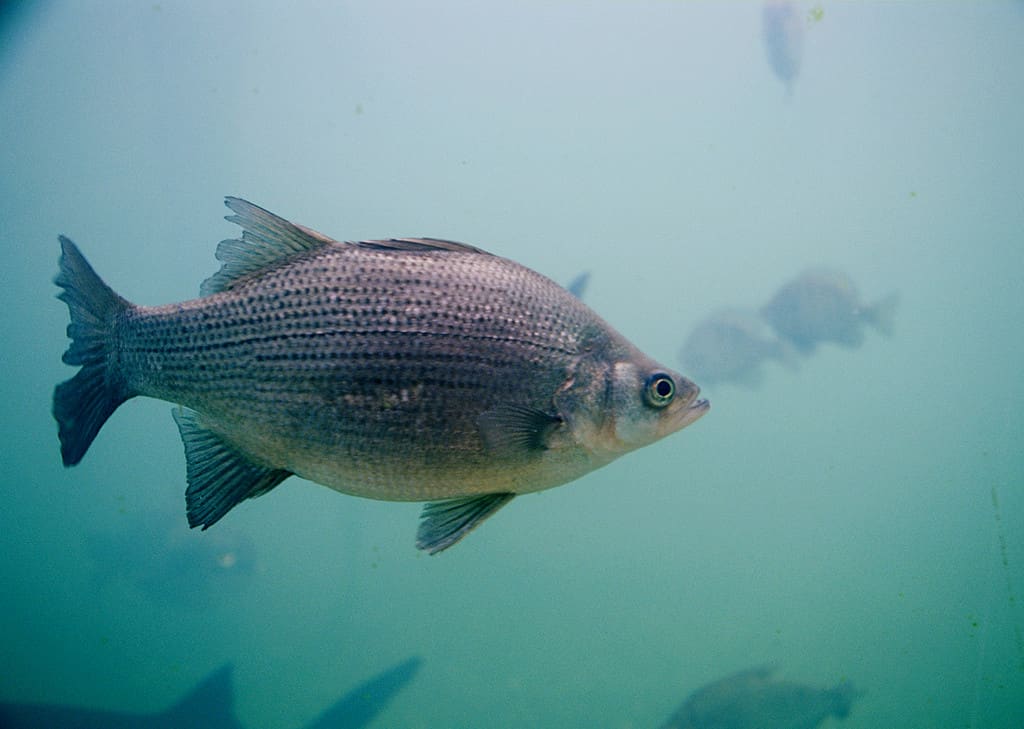Atlantic salmon are delicious, and they are favorites for many anglers to catch. These athletic fish are strong swimmers with a wide range. You can even find them in Illinois, although not as frequent as other states. Here in this article, we are going to review the largest Atlantic salmon ever caught in Illinois and fun facts about this fish species.
What is the Largest Atlantic Salmon Ever Caught in Illinois?
On May 26, 1979, Robert Lueckhoff caught an 18-pound and 11.25-ounce Atlantic salmon while fishing in Lake Michigan. This rare catch has stood standing for nearly 50 years. Although 18 pounds is impressive, this catch is nothing compared to the largest recorded Atlantic salmon. The largest salmon ever recorded in literature was netted in 1960 and weighed a jaw-dropping 109 pounds.

The largest Atlantic salmon ever caught in Illinois weighed 18 pounds and 11.25 ounces.
©Kevin Wells Photography/Shutterstock.com
About Atlantic Salmon
Atlantic salmon are fish in the family Salmonidae. They are the third largest fish within this family. Atlantic salmon live in the Atlantic Ocean and the rivers that flow into it. They aren’t very common in Illinois, so large catches are quite impressive.
Description and Size
Atlantic salmon are fast growers. After two years in the sea, Atlantic salmon are about 28 to 30 inches long and can weigh up to 11.9 pounds. Generally, the more time they spend feeding in the ocean, the larger they grow.
These lovely fish vary a lot in coloration. Juvenile and adult Atlantic salmon look very different. Adult Atlantic salmon are silver-blue with many black spots above the lateral line. When spawning, adult Atlantic salmon develop red spots and are bronze.

Atlantic salmon change appearance when traveling between freshwater and saltwater.
©Chanonry/Shutterstock.com
Diet
So, what do these large salmon fish eat? Atlantic salmon mainly consume other smaller fish. However, they also eat crustaceans, squids, and insects. Young and small Atlantic salmon mainly eat insects and zooplankton.
Distribution and Habitat
You can find Atlantic salmon in many parts of the world. They live throughout North America and Europe. You can fish for them off the Atlantic coast of the United States, Ireland, and northwestern Russia. They also inhabit Greenland and Iceland. Not all Atlantic salmon though live in the ocean. Some are completely landlocked. You can find “landlocked” Atlantic salmon in the Great Lakes and Lake Champlain. Although rare, you can still occasionally find Atlantic salmon in Illinois. According to the Illinois Department of Natural Resources, Atlantic salmon were stocked in Lake Michigan until the 1990s but a breeding population was not established. Still, sometimes these fast-swimming fish migrate from Lake Huron to Lake Michigan.

Atlantic salmon live in the Atlantic Ocean but travel to freshwater rivers to spawn. Some populations are landlocked.
©slowmotiongli/Shutterstock.com
Predators
The largest predator of Atlantic salmon is humans. However, these fish are also hunted by Atlantic halibut, Atlantic bluefin tuna, mako sharks, striped bass, seabirds, and swordfish. Harbor seals and river otters also eat Atlantic salmon. To protect themselves from predators in the ocean, some Atlantic salmon travel in large groups. The shine from their scales confuses predators, likely confusing them for larger predators. They also swim in deep parts of the ocean and swim deeper away when near their predators.

Mako sharks commonly eat Atlantic salmon.
©Xavier ELIAS Photography/Shutterstock.com
Other Fish in Illinois
Although it’s rare to find and catch an Atlantic salmon in Illinois, there are still plenty of common fish species well worth the hunt. Follow along to discover some fish species found throughout the state and their state records.
Bluegill
Starting our list of fish in Illinois is the bluegill. This wonderful vibrant fish is native to parts of North America, including east of the Rocky Mountains. They are very important fish to their environment. Bluegills have a lot of predators, including turtles, river otters, birds, northern pike, and trout. These fish are about 4 to 12 inches long, although they can reach up to 16 inches. They typically weigh less than 2 pounds. So, how does Illinois’ state record compare? The largest bluegill ever caught in Illinois was 3 pounds and 8 ounces. Darren May caught this impressive bluegill on May 10, 1987, in a private pond.

The largest bluegill ever caught in Illinois was nearly 4 pounds!
©iStock.com/Dewitt
Smallmouth Bass
Smallmouth bass are very common in Illinois. They are freshwater fish found throughout the United States. The native range of smallmouth bass is the upper and middle Mississippi River basin, the Saint Lawrence River–Great Lakes system, and the Hudson Bay basin. These muscular fast-swimming smallmouth bass weigh about 2 to 6 pounds. However, the largest recorded smallmouth bass weighed about 12 pounds. It was caught in Tennessee. The largest smallmouth bass caught in Illinois is impressive, but about half the weight of the world record. Mark Samp caught a 6-pound and 7-ounce smallmouth bass in a strip mine lake in 1985.

Most smallmouth bass weigh between 2 to 6 pounds. Females are larger than males.
©iStock.com/LaSalle-Photo
Northern Pike
Another common fish species in Illinois is the northern pike. Northern pike fish are very long fish native to moderately salty and fresh waters of the Northern Hemisphere. They have a wide range and are listed as Least Concern on the IUCN Red List. Northern pike on average are 16 to 22 inches long, however, they can reach as long as 59 inches. Northern pike mainly live in sluggish water with vegetation. They are ambush predator, patiently waiting for their prey. Northern pike fish are also cannibalistic and may eat younger pike. In Illinois, the largest northern pike ever caught weighed 26 pounds and 15 ounces. Walter Klenzak found this fish in 1989 in a strip mine lake.

Northern pike are large ambush predators that can measure up to 59 inches long.
©bekirevren/Shutterstock.com
Channel Catfish
The next fish on our list is the channel catfish. This large catfish is native to the Nearctic but is common throughout the world. They’ve been widely introduced throughout Europe, South America, and Asia. Channel catfish are favorites for many anglers because of their fight and massive size. Channel catfish are excellent hunters and use their keen sense of smell and taste. These fish range a lot in size. They may weigh as little as 4 pounds or as much as 58 pounds. They are also about 1 to 2 feet long. The largest channel catfish ever caught in Illinois is incredibly impressive at 45 pounds and 4 ounces. On February 7, 1987, Todd Baumeyer caught this fish in Baldwin Lake.

The world record channel catfish weighed 58 pounds.
©Aleron Val/Shutterstock.com
Longnose Gar
Longnose gars are also found throughout Illinois. This large fish has a wide range. You can find them throughout North America. They are living fossils with many similarities to their ancestors. For instance, longnose gars still have a spiral valve intestine. Longnose gars have torpedo-shaped bodies and an elongated snout or ‘nose’. They are calm fish, mainly seen floating in groups with other gars. So, just how long can these fish get? Longnose gars are about 28 to 48 inches long. These beasts can weigh up to 55 pounds.

Longnose gar populations in North America face habitat loss, overfishing, invasive species, and pollution threats.
©Mikhail Blajenov/Shutterstock.com
White Bass
Last but not least is the white bass. This small shimmering bass species is very common in the United States. It’s about 12 to 15 inches long. White bass aren’t entirely white. Their bodies are typically silver-white to pale green. They also have dark backs and narrow dark stripes running along their bodies. White bass are very common in Illinois. The state record was caught in 1981. Bruce Wilson caught the 4-pound and 14-ounce record white bass in the Kaskaskia River.

White bass are about 12 to 15 inches long.
©Eric Engbretson / Public domain – License
The photo featured at the top of this post is © JaySi/Shutterstock.com
Thank you for reading! Have some feedback for us? Contact the AZ Animals editorial team.






